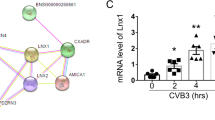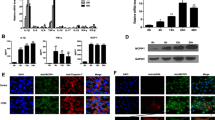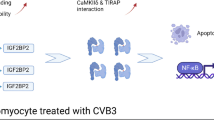Abstract
Objective
The coxsackie and adenovirus receptor (CAR) mediates the entry of coxsackievirus B (CVB) and adenovirus into host cells and is, therefore, a key determinant for the molecular pathogenesis of viral diseases such as myocarditis. The aim was to investigate the influence of HMG-CoA reductase inhibitor lovastatin on CAR expression in endothelial cells.
Methods
Human umbilical vein endothelial cells (HUVECs) were exposed to different concentrations of lovastatin (0.05–5 μmol/l) for up to 48 h. Alterations in CAR expression were examined by quantitative real-time PCR (qRT-PCR) and flow cytometry. In addition, after treatment with 1 μmol/l lovastatin for 48 h, HUVECs were infected for 8 h with CVB3 and virus replication was detected by qRT-PCR using viral-specific TaqMan probes.
Results
We found that lovastatin decreases CAR mRNA expression by up to 80 % (p < 0.01) and CAR protein expression by up to 19 % (p < 0.01), in a concentration-dependent manner. Moreover, virus replication of CVB3 was significantly inhibited after lovastatin treatment (p < 0.05). The signaling mechanism of CAR down-regulation by lovastatin depends on the Rac1/Cdc42 pathway.
Conclusion
This study shows for the first time that lovastatin reduces the expression of CAR and subsequently the replication of CVB3 in HUVECs.








Similar content being viewed by others
References
Cohen CJ, Shieh JT, Pickles RJ, Okegawa T, Hsieh JT, Bergelson JM. The coxsackievirus and adenovirus receptor is a transmembrane component of the tight junction. Proc Natl Acad Sci USA. 2001;98(26):15191–6.
Zen K, Liu Y, McCall IC, Wu T, Lee W, Babbin BA, et al. Neutrophil migration across tight junctions is mediated by adhesive interactions between epithelial coxsackie and adenovirus receptor and a junctional adhesion molecule-like protein on neutrophils. Mol Biol Cell. 2005;16(6):2694–703.
Carson SD. Receptor for the group B coxsackieviruses and adenoviruses: CAR. Rev Med Virol. 2001;11(4):219–26.
Fechner H, Haack A, Wang H, Wang X, Eizema K, Pauschinger M, et al. Expression of coxsackie adenovirus receptor and alphav-integrin does not correlate with adenovector targeting in vivo indicating anatomical vector barriers. Gene Ther. 1999;6(9):1520–35.
Tomko RP, Xu R, Philipson L. HCAR and MCAR: the human and mouse cellular receptors for subgroup C adenoviruses and group B coxsackieviruses. Proc Natl Acad Sci USA. 1997;94(7):3352–6.
Shaw CA, Holland PC, Sinnreich M, Allen C, Sollerbrant K, Karpati G, et al. Isoform-specific expression of the coxsackie and adenovirus receptor (CAR) in neuromuscular junction and cardiac intercalated discs. BMC Cell Biol. 2004;5(1):42.
Honda T, Saitoh H, Masuko M, Katagiri-Abe T, Tominaga K, Kozakai I, et al. The coxsackievirus-adenovirus receptor protein as a cell adhesion molecule in the developing mouse brain. Brain Res Mol Brain Res. 2000;77(1):19–28.
Ito M, Kodama M, Masuko M, Yamaura M, Fuse K, Uesugi Y, et al. Expression of coxsackievirus and adenovirus receptor in hearts of rats with experimental autoimmune myocarditis. Circ Res. 2000;86(3):275–80.
Noutsias M, Fechner H, de Jonge H, Wang X, Dekkers D, Houtsmuller AB, et al. Human coxsackie-adenovirus receptor is colocalized with integrins alpha (v)beta (3) and alpha (v)beta (5) on the cardiomyocyte sarcolemma and upregulated in dilated cardiomyopathy: implications for cardiotropic viral infections. Circulation. 2001;104(3):275–80.
Feldman AM, McNamara D. Myocarditis. N Engl J Med. 2000;343(19):1388–98. doi:10.1056/NEJM200011093431908.
Martino TA, Liu P, Sole MJ. Viral infection and the pathogenesis of dilated cardiomyopathy. Circ Res. 1994;74(2):182–8.
Coyne CB, Bergelson JM. Virus-induced Abl and Fyn kinase signals permit coxsackievirus entry through epithelial tight junctions. Cell. 2006;124(1):119–31. doi:10.1016/j.cell.2005.10.035.
Richardson P, McKenna W, Bristow M, Maisch B, Mautner B, O’Connell J, et al. Report of the 1995 World Health Organization/International Society and Federation of Cardiology Task Force on the Definition and Classification of cardiomyopathies. Circulation. 1996;93(5):841–2.
D’Ambrosio A, Patti G, Manzoli A, Sinagra G, Di Lenarda A, Silvestri F, et al. The fate of acute myocarditis between spontaneous improvement and evolution to dilated cardiomyopathy: a review. Heart. 2001;85(5):499–504.
Horstkotte D, Wiemer M, Piper C. Endokarditis und intravaskuläre infektionen. In: Adam D, Doerr HW, Link H, Lode H, editors. Die Infektiologie. Berlin: Springer; 2004. p. 354–69.
Kuhl U, Pauschinger M, Schwimmbeck PL, Seeberg B, Lober C, Noutsias M, et al. Interferon-beta treatment eliminates cardiotropic viruses and improves left ventricular function in patients with myocardial persistence of viral genomes and left ventricular dysfunction. Circulation. 2003;107(22):2793–8.
Grundy SM. HMG-CoA reductase inhibitors for treatment of hypercholesterolemia. N Engl J Med. 1988;319(1):24–33. doi:10.1056/NEJM198807073190105.
Mathur N, Ramasubbu K, Mann DL. Spectrum of pleiotropic effects of statins in heart failure. Heart Fail Clin. 2008;4(2):153–61. doi:10.1016/j.hfc.2008.01.007.
Klump WM, Bergmann I, Muller BC, Ameis D, Kandolf R. Complete nucleotide sequence of infectious Coxsackievirus B3 cDNA: two initial 5′ uridine residues are regained during plus-strand RNA synthesis. J Virol. 1990;64(4):1573–83.
Bergelson JM, Cunningham JA, Droguett G, Kurt-Jones EA, Krithivas A, Hong JS, et al. Isolation of a common receptor for Coxsackie B viruses and adenoviruses 2 and 5. Science. 1997;275(5304):1320–3.
Hirase T, Kawashima S, Wong EY, Ueyama T, Rikitake Y, Tsukita S, et al. Regulation of tight junction permeability and occludin phosphorylation by Rhoa-p160ROCK-dependent and -independent mechanisms. J Biol Chem. 2001;276(13):10423–31. doi:10.1074/jbc.M007136200.
Kureishi Y, Luo Z, Shiojima I, Bialik A, Fulton D, Lefer DJ, et al. The HMG-CoA reductase inhibitor simvastatin activates the protein kinase Akt and promotes angiogenesis in normocholesterolemic animals. Nat Med. 2000;6(9):1004–10. doi:10.1038/79510.
Davignon J, Laaksonen R. Low-density lipoprotein-independent effects of statins. Curr Opin Lipidol. 1999;10(6):543–59.
Bachmair A, Finley D, Varshavsky A. In vivo half-life of a protein is a function of its amino-terminal residue. Science. 1986;234(4773):179–86.
Varshavsky A. The N-end rule pathway of protein degradation. Genes Cells. 1997;2(1):13–28.
Carson SD. Limited proteolysis of the coxsackievirus and adenovirus receptor (CAR) on HeLa cells exposed to trypsin. FEBS Lett. 2000;484(2):149–52.
Excoffon KJ, Gansemer N, Traver G, Zabner J. Functional effects of coxsackievirus and adenovirus receptor glycosylation on homophilic adhesion and adenoviral infection. J Virol. 2007;81(11):5573–8. doi:10.1128/JVI.02562-06.
Li X, Liu L, Tupper JC, Bannerman DD, Winn RK, Sebti SM, et al. Inhibition of protein geranylgeranylation and RhoA/RhoA kinase pathway induces apoptosis in human endothelial cells. J Biol Chem. 2002;277(18):15309–16. doi:10.1074/jbc.M201253200.
Zhong WB, Wang CY, Chang TC, Lee WS. Lovastatin induces apoptosis of anaplastic thyroid cancer cells via inhibition of protein geranylgeranylation and de novo protein synthesis. Endocrinology. 2003;144(9):3852–9.
Funke C, Farr M, Werner B, Dittmann S, Uberla K, Piper C, et al. Antiviral effect of bosentan and valsartan during coxsackievirus B3 infection of human endothelial cells. J Gen Virol. 2010;91(Pt 8):1959–70. doi:10.1099/vir.0.020065-0.
Bergelson JM, Modlin JF, Wieland-Alter W, Cunningham JA, Crowell RL, Finberg RW. Clinical coxsackievirus B isolates differ from laboratory strains in their interaction with two cell surface receptors. J Infect Dis. 1997;175(3):697–700.
Shafren DR, Williams DT, Barry RD. A decay-accelerating factor-binding strain of coxsackievirus B3 requires the coxsackievirus-adenovirus receptor protein to mediate lytic infection of rhabdomyosarcoma cells. J Virol. 1997;71(12):9844–8.
Stuart AD, Eustace HE, McKee TA, Brown TD. A novel cell entry pathway for a DAF-using human enterovirus is dependent on lipid rafts. J Virol. 2002;76(18):9307–22.
Goldstein JL, Brown MS. Regulation of the mevalonate pathway. Nature. 1990;343(6257):425–30. doi:10.1038/343425a0.
Van Aelst L, D’Souza-Schorey C. Rho GTPases and signaling networks. Genes Dev. 1997;11(18):2295–322.
Suh JW, Choi DJ, Chang HJ, Cho YS, Youn TJ, Chae IH, et al. HMG-CoA reductase inhibitor improves endothelial dysfunction in spontaneous hypertensive rats via down-regulation of caveolin-1 and activation of endothelial nitric oxide synthase. J Korean Med Sci. 2010;25(1):16–23. doi:10.3346/jkms.2010.25.1.16.
Feron O, Dessy C, Desager JP, Balligand JL. Hydroxy-methylglutaryl-coenzyme A reductase inhibition promotes endothelial nitric oxide synthase activation through a decrease in caveolin abundance. Circulation. 2001;103(1):113–8.
Casey PJ. Protein lipidation in cell signaling. Science. 1995;268(5208):221–5.
Hopkins AM, Li D, Mrsny RJ, Walsh SV, Nusrat A. Modulation of tight junction function by G protein-coupled events. Adv Drug Deliv Rev. 2000;41(3):329–40.
Wildenberg GA, Dohn MR, Carnahan RH, Davis MA, Lobdell NA, Settleman J, et al. p120-catenin and p190RhoGAP regulate cell–cell adhesion by coordinating antagonism between Rac and Rho. Cell. 2006;127(5):1027–39. doi:10.1016/j.cell.2006.09.046.
Utech M, Ivanov AI, Samarin SN, Bruewer M, Turner JR, Mrsny RJ, et al. Mechanism of IFN-gamma-induced endocytosis of tight junction proteins: myosin II-dependent vacuolarization of the apical plasma membrane. Mol Biol Cell. 2005;16(10):5040–52. doi:10.1091/mbc.E05-03-0193.
von Eichel-Streiber C, Boquet P, Sauerborn M, Thelestam M. Large clostridial cytotoxins—a family of glycosyltransferases modifying small GTP-binding proteins. Trends Microbiol. 1996;4(10):375–82. doi:10.1016/0966-842X(96)10061-5.
Hakoshima T, Shimizu T, Maesaki R. Structural basis of the Rho GTPase signaling. J Biochem. 2003;134(3):327–31.
Cotteret S, Chernoff J. The evolutionary history of effectors downstream of Cdc42 and Rac. Genome Biol. 2002;3(2):REVIEWS0002.
Rashid M, Tawara S, Fukumoto Y, Seto M, Yano K, Shimokawa H. Importance of Rac1 signaling pathway inhibition in the pleiotropic effects of HMG-CoA reductase inhibitors. Circ J. 2009;73(2):361–70.
Yuen S, Smith J, Caruso L, Balan M, Opavsky MA. The coxsackie-adenovirus receptor induces an inflammatory cardiomyopathy independent of viral infection. J Mol Cell Cardiol. 2011;50(5):826–40. doi:10.1016/j.yjmcc.2011.02.011.
Kallewaard NL, Zhang L, Chen JW, Guttenberg M, Sanchez MD, Bergelson JM. Tissue-specific deletion of the coxsackievirus and adenovirus receptor protects mice from virus-induced pancreatitis and myocarditis. Cell Host Microbe. 2009;6(1):91–8. doi:10.1016/j.chom.2009.05.018.
Shi Y, Chen C, Lisewski U, Wrackmeyer U, Radke M, Westermann D, et al. Cardiac deletion of the coxsackievirus-adenovirus receptor abolishes coxsackievirus B3 infection and prevents myocarditis in vivo. J Am Coll Cardiol. 2009;53(14):1219–26. doi:10.1016/j.jacc.2008.10.064.
Schonbeck U, Libby P. Inflammation, immunity, and HMG-CoA reductase inhibitors: statins as antiinflammatory agents? Circulation. 2004;109(21 Suppl 1):18–26. doi:10.1161/01.CIR.0000129505.34151.23.
Liu X, Li B, Wang W, Zhang C, Zhang M, Zhang Y, et al. Effects of HMG-CoA reductase inhibitor on experimental autoimmune myocarditis. Cardiovasc Drugs. 2012;26(2):121–30. doi:10.1007/s10557-012-6372-6.
Ye J, Wang C, Sumpter R Jr, Brown MS, Goldstein JL, Gale M Jr. Disruption of hepatitis C virus RNA replication through inhibition of host protein geranylgeranylation. Proc Natl Acad Sci USA. 2003;100(26):15865–70. doi:10.1073/pnas.2237238100.
Ikeda M, Kato N. Life style-related diseases of the digestive system: cell culture system for the screening of anti-hepatitis C virus (HCV) reagents: suppression of HCV replication by statins and synergistic action with interferon. J Pharmacol Sci. 2007;105(2):145–50.
Murayama T, Bi Ch, Li Y, Ishigaki Y, Takano F, Takegami T, Ohta T, Sumino H, Ubukata K, Takahasi T. Inhibitory effects of statins on cytomegalovirus production in human cells: comprehensive analysis of gene expression profiles. J Exp Clin Med. 2011;3(1):40–5.
Acknowledgments
We thank Hendrik Milting (PhD) for facilitating Real-Time PCR and Heike Seidenstücker for supporting viral infection studies. We also very much appreciate funding of our research by the FoRUM programme of the Ruhr-University Bochum (grant F722-11), and a donation by the Symnick-Foundation, Bielefeld, Germany.
Author information
Authors and Affiliations
Corresponding author
Additional information
Responsible Editor: Ikuo Morita.
Electronic supplementary material
Below is the link to the electronic supplementary material.
Rights and permissions
About this article
Cite this article
Werner, B., Dittmann, S., Funke, C. et al. Effect of lovastatin on coxsackievirus B3 infection in human endothelial cells . Inflamm. Res. 63, 267–276 (2014). https://doi.org/10.1007/s00011-013-0695-z
Received:
Revised:
Accepted:
Published:
Issue Date:
DOI: https://doi.org/10.1007/s00011-013-0695-z




